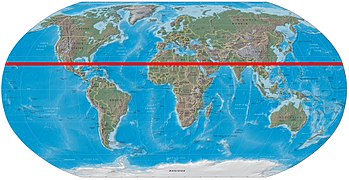Tropic of Cancer
- For the novel by Henry Miller, see Tropic of Cancer (novel).

The Tropic of Cancer, or Northern tropic, is one of the five major circles of latitude that mark maps of the Earth. It is the most northerly latitude at which the sun can appear directly overhead at noon. This event occurs at the June solstice, when the northern hemisphere is tilted towards the sun to its maximum extent.
The Tropic of Cancer currently lies 23° 26′ 22″ north of the Equator. North of this latitude are the subtropical and Northern Temperate Zone. The equivalent line of latitude south of the equator is called the Tropic of Capricorn, and the region between the two, centred on the Equator, is known as the Tropics.
The line is called Tropic of Cancer because when it was named the sun was in the constellation of Cancer (Latin for crab) at the June solstice. However, due to the precession of the equinoxes, the sun is now in the constellation of Taurus at the June solstice. The word "tropic" itself comes from the Greek tropos, meaning turn, referring to the fact that the sun appears to "turn back" at the solstices.
The position of the Tropic of Cancer is not fixed, but varies in a complex manner over time; see under circles of latitude for information.
Geography

The Tropic of Cancer passes through the following countries (going east):
- United States of America (Hawaii) - sea area only, misses every island, passing between Nihoa and Necker Island
- Mexico, just north of Mazatlan on the Pacific
- Bahamas
- Western Sahara (claimed by Morocco)
- Mauritania
- Mali
- Algeria
- Niger
- Libya
- Chad – Its northernmost point is defined by the Tropic of Cancer.
- Egypt
- Saudi Arabia
- United Arab Emirates
- Oman
- India
- Bangladesh
- Myanmar
- People's Republic of China, just north of Guangzhou, also known as Canton
- Republic of China (Taiwan)
Trivia
According to the Fédération Aéronautique Internationale's rules, for a flight to compete for a round-the-world speed record, it must cover a distance no less than the length of the Tropic of Cancer as well as cross all meridians and end on the same airfield where it started. This length is set to be 36787.559 kilometres - a number implying an accuracy which does not exist, considering the variations of the tropic described above.
For an ordinary circumnavigation the rules are somewhat relaxed and the distance is set to a rounded value of 37000 kilometres.
